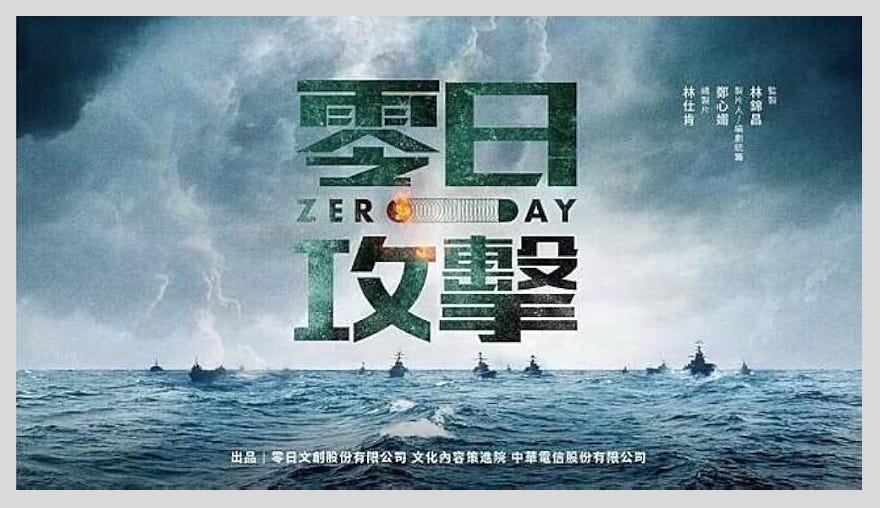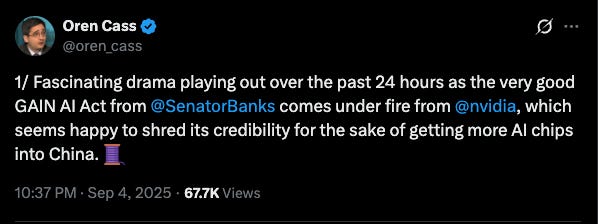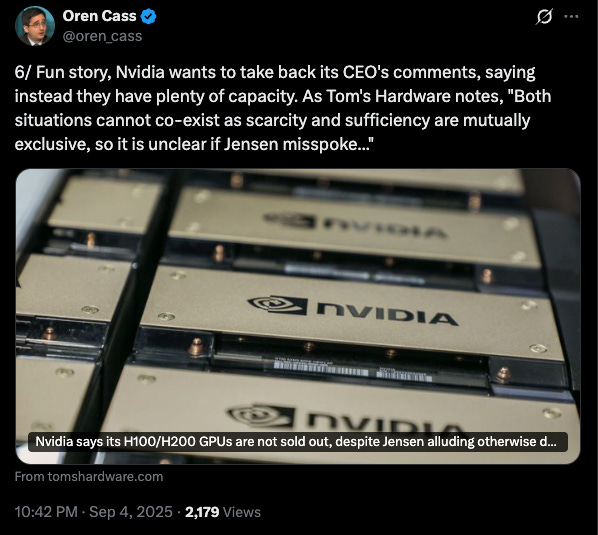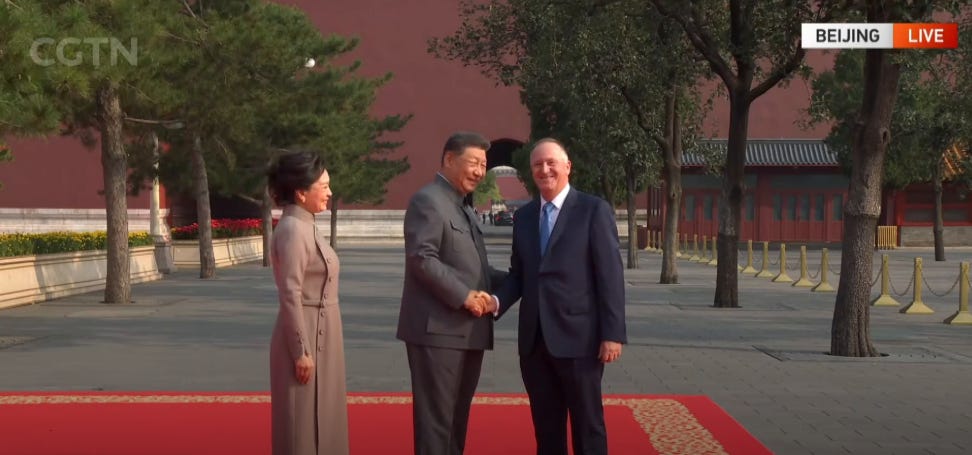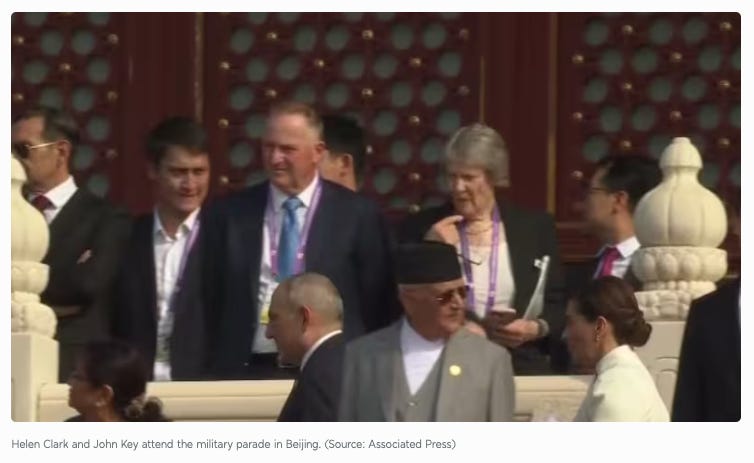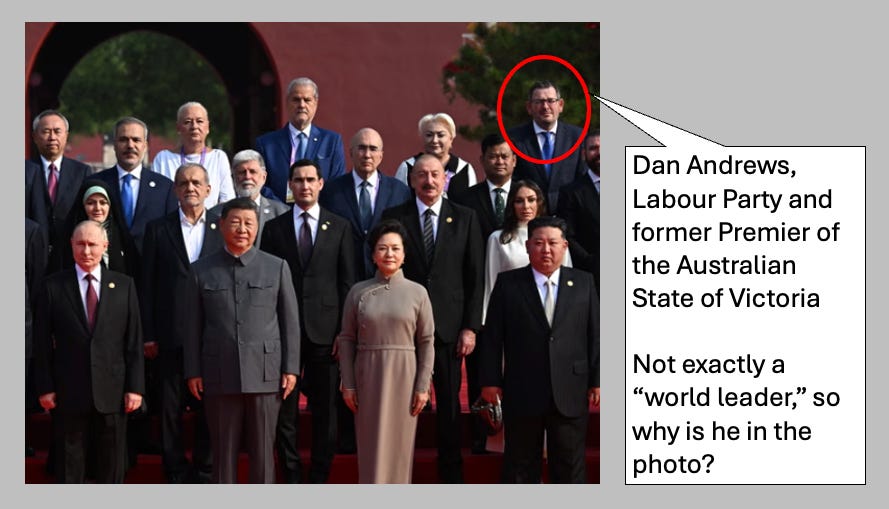Zero Day Attack
How Fiction helps us understand Truth
Friends,
This week, I attended the U.S. premiere of Zero Day Attack that was put on by the Global Taiwan Institute (GTI) at George Washington University.
Produced by Taiwanese screenwriter, Cheng Hsin-mei, it is a ten-episode series that looks at the start of a PRC invasion of Taiwan from the perspectives of ten different people across Taiwanese society. I saw the first episode, as well as the tenth and final episode, which hasn’t even aired in Taiwan yet.
It is in Chinese with English subtitles and filmed on location across Taiwan, including inside the Presidential Office Building, so lots of familiar sites.
I thought it was well done. The episodes focus on how the Chinese Communist Party’s coercion and aggression elicit a range of human responses by both powerful and regular Taiwanese citizens. We witness fear, cowardness, anger, and courage. I won’t give anything away, but if you get a chance to watch it, you should do it.
Which raises the question: where can you watch this series?
Right now, you would need to be in Taiwan or in Japan, as those are the only places so far that the producers have been able to get a streaming service to air this 10-episode drama.
They are negotiating with other streaming platforms… but, perhaps unsurprisingly… the PRC is pressuring those companies to not air this series. Based on what I can find online, Netflix has already refused to air the series. It is being shown on Amazon Prime Video, but only in Japan.
Hopefully, GTI will be able to set up other screening events in the United States. It would be great to find some European partners who would be willing to set up screening events in their countries too.
Unfortunately, the CCP and its friends will likely be successful at suppressing this drama, just as they have been successful for years at suppressing political and dramatic portrayals of perhaps the most likely and consequential form of PRC aggression.
I’m reminded of the Norwegian series Occupied (or Okkupert in Norweigian) which first aired 2015 and was widely distributed by Netflix. The show dramatizes a Russian invasion of Norway and the acquiescence by the European Union and NATO to Moscow’s de facto control over Norway. The series was widely shown across Europe and the United States in the years following Russia’s seizure of Crimea from Ukraine and likely had some influence in helping Europeans become more prepared for further Russian aggression over the past decade.
Or the Finnish-American TV miniseries Conflict (or Knoflikti in Finnish) which was released last year about a Russian mercenary invasion of Finland. This series has run on Apple TV.
Both of these series, which revolve around the impacts of potential Russian aggression, helped spur discussions and thinking across these societies. Drama and fiction help people cope with and prepare for things they would rather not think about.
One would hope that Zero Day Attack could play a similar role, helping citizens through fiction and drama understand what might happen as the PRC becomes increasingly aggressive against its neighbors.
It looks like Beijing is better positioned to squash this sort of discussion. One theme we’ve seen is that Zero Day Attack should be dismissed as purely DPP (Democratic Progressive Party) propaganda. For an example, take a look at this story from a month ago by the BBC, “Propaganda or fair warning? Taiwanese TV show imagines Chinese invasion.”
Rather than take seriously the issues raised by the show, these BBC reporters spend more than half the article obsessed with the DPP’s connection to the production and say nothing about the fact that decades of CCP coercion against the Taiwanese film industry has made it nearly impossible for anyone to make a series like this WITHOUT government support.
Moscow hated both Occupied and Conflict because these fictional series provided truths that news articles and think tank reports can’t communicate. Theses dramas demonstrated that Norwegians, Finns, and Europeans could stand up to Russian coercion, that they weren’t powerless in the face of Russian aggression. It showed that democracies can prevail and that not everyone can be bought off.
Zero Day Attack provides a similar message. While Taiwanese people may not agree on everything, they can defend themselves, they are NOT powerless in the face of Chinese aggression. Standing up for what they believe in is not provocative.
Beijing hates that message because it fundamentally undermines the CCP’s strategy of political and psychological warfare against the Taiwanese people. The Party’s strategy depends on intimidation and fear. Fear of an invasion IF the Taiwanese people stand up for themselves or express their desire to govern themselves. It coerces individuals to self-censor; it employs fear of invasion to pressure individuals to not talk about a potential invasion.
When Beijing demands that folks not watch this series or dismisses it as “propaganda,” we should ask what kind of drama would the CCP produce to demonstrate what life would be like under the Party’s annexation of Taiwan? We have an example of what that would look like, it is Hong Kong. It is the destruction of a community and a culture that made Hong Kong special… now Hongkongers live in fear of being arrested and re-educated.
The best thing we could all do to counter the CCP’s political and psychological warfare strategy is to watch this series and talk about it.
***
#nvidiahypocrisy
I thought I’d include a great Twitter/X thread from Oren Cass, the founder of the think tank American Compass, that illustrates a point I’ve been trying to make since the disastrous cave by the Trump Administration to Nvidia’s lobbying.
Of course, Nvidia isn’t taking this lying down.
By associating Senator Banks’ (R-IN) legislation with the Biden Administration AI Diffusion Rule, Nvidia hopes that the suitcases of money it used to kill that rule will work again.
Nvidia is trying hard to convince folks that there is no scarcity of Nvidia chips…
"We never deprive American customers in order to serve the rest of the world,"… an Nvidia spokesperson said.
…even as its entire stock price rests on the perception that there is a scarcity of Nvidia chips.
Maybe the U.S. Government should take a “golden share” of Nvidia and then the executive branch and Congress could see for themselves whether every American customer that wants Nvidia chips can get them before Nvidia sells chips to the PRC.
I suspect that Jensen wouldn’t want to do that, so the GAIN Act (Guaranteeing Access and Innovation for National Artificial Intelligence Act) seems like a good compromise… why shouldn’t an American chip company be forced to prioritize domestic orders for advanced AI chips? Nvidia benefits a lot from being an American company… not the least being its ability to use export restricted tools to make all of its products.
Nvidia’s opposition to the law suggests that Jensen is actually more interested in “Making China Great Again.”
For more on Oren Cass, I recommend watching his March 31, 2025, interview with Jon Stewart on The Daily Show.
It’s an interesting interview conducted two days before Trump’s global reciprocal tariffs.
***
Next week (or in the coming weeks), I plan to flesh out a few topics I’ve been mulling over:
I’ve been thinking about the thesis that America’s “China policy” is less about China and more about the United States. The clip of Jon Stewart’s interview with Oren Cass helps demonstrate my point, as “China policy” provides a microcosm of the completing constituencies, varying interests, and opposing visions that groups of Americans across the political spectrum have about America’s place in the world and what we should be doing. “China policy” sits at the center of America’s political realignment and touches every aspect of public policy. Therefore “China policy” is not the unique preserve of China-hands, where the number of visits to Shanghai or Shenzhen qualify one as an expert, but it is something that everyone must consider.
How should we interpret the Sino-American-Indian “love triangle”? Modi’s visit last week with Xi and Putin has brought this topic back into the center of our thinking on geopolitics. Jake Sullivan and Kurt Campbell provided an important contribution to this debate with their article in Foreign Affairs last week titled “The Case for a U.S. Alliance With India: Washington Should Draw New Delhi Closer, Not Push It Away” but it begs the question that Ashley Tellis raised in his Foreign Affairs article three months ago (“India’s Great-Power Delusions: How New Delhi’s Grand Strategy Thwarts Its Grand Ambitions”), perhaps it is New Delhi that does NOT want an alliance with the United States? Just because Washington wants something, doesn’t mean it will happen… America isn’t the only country with agency.
The rules-based, liberal international order has run its course, and a new international order is emerging. The Trump Administration sees this opportunity and is trying to re-engineer the global economic, trading, financial, security, and industrial order. What options are available? And what should we want the new international order to look like? What attributes would be advantageous and what attributes would undermine our values and interests? What are our values and interests? Whether we like it or not, the world is changing. For too long the politics of the West have been in denial about this fact. Our political economy has been stuck in a world that no longer exists. It is time for us to start imagining the future again rather than clinging to a past that is fading in our rearview mirror. Rahm Emanuel, potential Democratic presidential candidate in 2028, provides some insight on how we might approach this issue in his OpEd in the Wall Street Journal two weeks ago, titled “We Have Met the Enemy and He Isn’t Us.”
If you want to support this work, consider becoming a paid subscriber below.
Thanks for reading!
Matt
MUST READ
Xi Wages ‘Memory War’ on China’s WWII History with Eye on Taiwan
Gerry Doyle, Becca Wasser and Alastair Gale, Bloomberg, September 2, 2025
Outside a rain swept mountaintop museum where Chinese forces fought a key battle against Japan in 1940, footage of President Xi Jinping last month blared out of a giant television.
The video from his July visit to Yangquan in Shanxi province, shows the nation’s top leader telling students assembled at the exhibition how “the Communist Party of China was the backbone of the nation’s war of resistance” against Japan.
His decision to commemorate the 17,000 Chinese dead and wounded 85 years later is part of a broader campaign to reshape global discussions about World War II. By emphasizing such sacrifices, Xi aims to position the Communist Party as a victor of the war equal to the US — even though the CCP didn’t take power until four years after Japan’s surrender.
Echoing similar efforts by Russian leader Vladimir Putin, China’s top leader is turning to history to achieve his goals and rally patriotism in a country grappling with a weak job market and housing crisis. His campaign is aimed at shoring up Beijing’s claim over self-ruled Taiwan and bolstering its status as a pillar of the postwar world order, just as Donald Trump pulls the US away from institutions it has dominated for decades.
That push will be on full display Wednesday when Xi presides over a military parade in Beijing to mark the 80th anniversary of Japan’s formal surrender. The event is part of a decade-long political project for Xi: China’s top legislature in 2014 declared Sept. 3 as “Victory Day” for China over Japan and soon after held the nation’s first parade to commemorate it.
“Beyond martial splendor and visual reminders of these nations’ contributions to the war effort, the parades are part of an ongoing memory war,” Kainan Gao and Margaret Pearson wrote in research published last week by the Brookings Institution. “Reminding the West of the forgotten Chinese sacrifices and contributions, including and especially those of the Communist Party, is seen to bolster the case for righting past ‘wrongs.’”
COMMENT – I recommend reading the piece by Kainan Gao and Margaret Pearson from Brookings as well, titled, “Military parades and memory wars: China and Russia commemorate history to reimagine international order.”
Tianjin Declaration
Bert Hofman, Bert’s Newsletter, September 1, 2025
COMMENT – Bert Hofman at the National University of Singapore and the World bank’s former China Director did a great job translating the “Tianjin Declaration” issued at last week’s meeting of the Shanghai Cooperation Organization (SCO). It is worth reading, as well as subscribing to Bert’s Substack newsletter titled Bert’s Newsletter.
Sir John Key and Helen Clark attend Beijing military parade
1news.co.nz, September 3, 2025
Former [New Zealand] Prime Ministers Sir John Key and Helen Clark have appeared at a military parade hosted by China, also attended by Russian President Vladimir Putin and North Korean leader Kim Jong-un.
The duo, former political rivals, arrived at the parade in Beijing together – both shaking hands and taking photos with Chinese President Xi Jinping.
COMMENT – Oh New Zealand… come on… you sent TWO former prime ministers to Xi Jinping’s parade of dictators and world domination?!?
Who could have imagined that New Zealand politicians from across their political spectrum could be so supportive of an anti-liberal international order. I guess they believe that Beijing and Moscow will eventually dominate the globe and it is in their interests to be seen as supporting Xi and Putin as early as possible.
The Australians only sent the dodgy former Premier of Victoria, Dan Andrews, who had entered into a Belt and Road Initiative agreement with Beijing while he was in office in 2018 and kept it secret for five weeks until he was forced under public pressure to reveal it to the public.
One wonders how these folks justify their actions to themselves.
A Hidden Camera Protest Turned the Tables on China’s Surveillance State
Li Yuan, New York Times, September 2, 2025
COMMENT – This is absolutely brilliant… the video of Chongqing police scrambling around the hotel room trying to figure out how to turn off the projector was masterful. One police officer finally notices the camera focused on the room.
It just goes to show that even as Xi and the Party try to project dominance, normal Chinese citizens see through the Party’s BS and are willing to speak truth to power.
“Overthrow the tyranny of the Communist Party!”
“Rise up, you who refuse to be slaves”
“Freedom is no gift – take it back”
I also love how the activist left a note on the coffee table of the hotel room for the police to find, saying: “Even if you are a beneficiary of the system today, one day you will inevitably become a victim on this land… So please treat the people with kindness.”
Major NBA brands linked to forced labour in China
Daniel Murphy, The Bureau of Investigative Journalism (TBIJ), August 30, 2025
Li-Ning, Anta and 361 Degrees all own facilities linked to Uyghur oppression – with Nike’s supply chain also tainted.
When Enes Kanter Freedom appeared on a basketball court in his Boston Celtics jersey and a pair of trainers emblazoned with the slogan “Free Uyghur”, the reaction from Beijing was swift.
“Literally at the half-time, they cancelled every Celtics game on television [in China] for the rest of the year,” the basketball player told the Bureau of Investigative Journalism (TBIJ) and the Guardian. That game, in October 2021, marked a turning point in his career. “That’s when the NBA got really angry at me,” said Freedom.
Freedom, who has long been an outspoken critic of the Turkish government, had researched the issue after the concerned father of a fan challenged his silence on China’s treatment of Muslim minorities.
In Xinjiang, China’s westernmost region, President Xi Jinping’s “war on terrorism” has involved oppression and detentions as a means of forcing ethnic minorities to assimilate into the dominant Chinese culture. Uyghurs and other minorities have been imprisoned in re-education camps and pressured into forced labour at factories across the country.
Freedom was already used to making statements in unconventional ways; he’d changed his surname from Kanter on becoming an American citizen. And as he dug deeper, he found it hard to believe that people weren’t more aware of what was happening in Xinjiang. So he decided to do something about it.
“I reached out to these artists around the world, and I told them to put all their struggles on the shoe,” he said. “And I’m gonna go out there and play basketball.”
That was the 11th year of Freedom’s NBA career. It would be his last.
Teammates began to warn him, he later testified in front of Congress, that he’d never play in the league again. Shortly afterwards, he was released from his contract – a move the NBA says had nothing to do with his activism.
The cancelled Celtics broadcasts weren’t the first time Beijing had punished the NBA: in 2019, Chinese state media pulled games from its schedule after NBA commissioner Adam Silver defended the actions of Daryl Morey, a Houston Rockets executive, who had tweeted support for protesters in Hong Kong. The affair cost the NBA hundreds of millions of dollars.
China is a multibillion-dollar market for the NBA, with more basketball fans than the US has people. Freedom says the league is beholden to Chinese interests.
It’s also a huge platform for Chinese brands to advertise themselves to the world. The Chinese sportswear brand Li-Ning has been using NBA players to promote its footwear for over a decade, ever since Dwyane Wade ended his contract with Nike’s Jordan subsidiary and signed with the Chinese company in 2012.
COMMENT – The CCP hates this stuff… I wonder if there are any NBA players with the courage to do this again.
Li-Ning and other Chinese brands like Anta and 361 Degrees now compete with legacy American companies for lucrative sponsorship deals. Over a dozen NBA players had deals with the three brands in 2022, according to analysis from ESPN.
Li-Ning has deals with the Golden State Warriors’ Jimmy Butler – also lured from Jordan in 2020 for a huge deal that includes various signature shoe lines – and Fred VanVleet of the Houston Rockets, who is president of the National Basketball Players Association. Anta sponsors stars including Klay Thompson and Kyrie Irving, while 361 Degrees’ roster includes the Serbian legend Nikola Jokić. (These sponsorship deals are made with the players directly and are not subject to NBA approval.)
None of these players’ representatives responded to requests for comment.
Now, TBIJ and the Guardian can reveal that all three brands are linked to the oppression Freedom highlighted on his trainers. And so is Nike.
Leveraging forced labour
Earlier this year, a major investigation by TBIJ, the New York Times and Der Spiegel connected more than 100 global brands to the Xinjiang labour transfer scheme that moves ethnic minorities thousands of miles across China to work in eastern factories. The transfer scheme is a central pillar of the Chinese government’s systematic destruction of the Uyghur, Kazakh and Kyrgyz communities of Xinjiang.
Anta, Li-Ning and 361 Degrees are among the brands that directly own production sites linked to these human rights abuses. And the sportswear labels are also supplied by other companies participating in the labour transfer program.
A 361 Degrees factory in Fujian has taken Xinjiang workers for at least a decade: a “collective wedding” of Kazakh workers at the factory in 2015 referred to nearly 400 workers. Social media content from Xinjiang workers showing the factory compound was uploaded as recently as last year.
At least three factories supplying Li-Ning have used workers from the labour transfer scheme. One clip uploaded by a Uyghur worker shows a pair of black and silver Li-Ning trainers on a conveyor belt at a factory in Hubei.
“Life is too hard, but I don’t want to admit defeat,” reads the title of a video from a worker at a different Li-Ning supplier. “This guy is really ordering people to work a lot,” says the accompanying voiceover in Uyghur, referring to a Han Chinese supervisor who stands nearby, hands on hips. “If I don’t get out of here I know I’m gonna work myself to death.”
361 Degrees’ sponsorships stretch beyond the NBA to World Aquatics events and Olympic runners. Li-Ning’s partnerships, meanwhile, include China’s Olympic delegation and a clutch of young badminton pros in the UK. The brand has also made a point of supporting Beijing’s approach to Xinjiang.
When global businesses began to remove Xinjiang cotton from their supply chains after concerns about forced labour in the fields, Li-Ning kept “made with Xinjiang cotton” on its clothing labels. While Nike and other global brands faced furious backlash from Chinese consumers for ceasing to use Xinjiang cotton – amplified by state media campaigns – Li-Ning’s sales and share price surged.
Sporting partnerships of this sort allow these companies to bolster China’s soft power. When the Houston Rockets executive Morey made his statement in support of Hong Kong, Li-Ning and Anta both announced they would be halting their partnerships with the team.
Li-Ning told us it “strictly opposes and prohibits any form of forced labour” in its supply chain and regularly audits its suppliers, with a “zero-tolerance” policy enforced. It added that the company “always upholds human rights and the legal rights of labour”.
361 Degrees and Anta did not respond to requests for comment.
Mike Bass, an NBA spokesperson, said: “We have always supported and will continue to support every member of the NBA family, including Enes Freedom, expressing their personal views on social and political issues. We will continue to follow US government guidance and policy regarding operating in China and more than 200 other countries and territories around the world where we engage fans.”
Freedom isn’t surprised to hear that half a dozen factories in the supply chains of Li-Ning, Anta and 361 Degrees are tied to Xinjiang forced labour. But there’s one brand above all that he has questions for – and he has been asking them for the last four years.
‘Selective activism’
“Who makes your shoes in China? Do you even know?” Freedom demanded of Nike in a video posted to Twitter (now X) in 2021.
Nike has been a major commercial partner of the NBA since 1992 and last year signed on to be the league’s outfitting, merchandising, marketing and content partner until 2037 – a deal reportedly worth well over $1bn.
Freedom’s questions came after Nike had been connected to a sneaker factory in Shandong province that had taken Uyghur transfer workers. Nike maintained that the supplier had stopped hiring workers from Xinjiang and that inspections had confirmed this.
“Our ongoing diligence has not found evidence of employment of Uyghurs, or other ethnic minorities from [Xinjiang], elsewhere in our supply chain in China,” it said at the time.
But TBIJ has found sources that link Nike to Fulgent Sun, a footwear manufacturer in Fujian province that has long absorbed workers from Xinjiang. The factory started working with the government to bring Uyghur and Kyrgyz people to Fujian in 2013.
When approached with TBIJ’s findings, a Nike spokesperson said that the company had ended its relationship with the Fujian factory in 2015. They did acknowledge that Nike had sourced from an affiliated site in central China for its label Converse in recent years.
However, various sources – from industry press and academic articles to Fulgent Sun’s own corporate materials – point to Nike being an important customer over the past decade.
TBIJ pulled export records that showed multiple shipments from the Fujian factory to Nike in the US after 2015, including as recently as November 2022. The shipments were all delivered via one of the brand’s main logistics partners in the region.
After seeing some of TBIJ’s evidence, Nike said its records “contradicted [TBIJ’s] claims”, and maintained it hadn’t purchased anything from the implicated factory since 2015. It added that it “remains committed to ethical and responsible manufacturing”.
Fulgent Sun didn’t respond to requests for comment.
Freedom – who wore a pair of shoes emblazoned with “Nike Hypocrite”, “Made with slave labor” and “No more excuses” in one of his final NBA games – claims it was criticism of both China and Nike that cost him his career.
He’s saddened by what he calls selective activism from Nike, which has been a proud supporter of US-focused social justice movements like Black Lives Matter. “You stand up for things unless it hits your pocket, hurts you financially,” he said.
“Stand up for what’s right,” he added. Speaking to the NBA players sponsored by brands linked to human rights violations, he said: “Put yourself in their shoes. Imagine it was your sister or daughter. Would you still be silent?”
COMMENT – The NBA session starts on October 21… it would be courageous if players spoke out on this topic rather than help cover it up.
Pentagon-funded research at colleges has aided the Chinese military, a House GOP report says
Didi Tang and Collin Binkley, Associated Press, September 5, 2025
Over a recent two-year period, the Pentagon funded hundreds of projects done in collaboration with universities in China and institutes linked to that nation’s defense industry, including many blacklisted by the U.S. government for working with the Chinese military, a congressional investigation has found.
The report, released Friday by House Republicans on the Select Committee on the Chinese Communist Party, argues the projects have allowed China to exploit U.S. research partnerships for military gains while the two countries are locked in a tech and arms rivalry.
“American taxpayer dollars should be used to defend the nation — not strengthen its foremost strategic competitor,” Republicans wrote in the report.
“Failing to safeguard American research from hostile foreign exploitation will continue to erode U.S. technological dominance and place our national defense capabilities at risk,” it said.
This deserves Captain Picard’s classic two-handed facepalm
COMMENT – FFS… This is one of the most frustrating revelations after more than 15 years working on this stuff… my personal experience with the folks in DoD Research and Engineering aligns closely with what’s in this report and I still have a bruise from beating my head against that organization’s intransigence.
Here is the top line finding:
The Select Committee identified approximately 1,400 research papers published between June 2023 and June 2025, acknowledging DOD funding or research support that also involved collaboration with PRC entities, which included over 300 DOD grants. Of these, over 700 publications—or just over 50%—were conducted in partnership with entities affiliated with China’s defense research and industrial base.
This is AFTER Secretary of Defense Lloyd Austin identified the PRC as the Department’s pacing challenge… this isn’t from the 1990s or 2000s when folks were giddy about engagement.
It is really, really hard to pull away from your military rival technologically when they are sitting in the backseat of your car.
Here’s the report below…
The House Select Committee on the Chinese Communist Party, September 5, 2025
Over the past two years, the Select Committee on the Chinese Communist Party and the Committee on Education and the Workforce’s (Committees) investigations revealed how the Chinese Communist Party (CCP) exploits U.S. universities—and gains access to U.S. government-funded research—to fuel its military and technological rise.
The U.S. Department of Defense (DOD) funds research for the purpose of achieving technological breakthroughs to equip future warfighters. The Select Committee undertook an extensive review of DOD-funded research projects that also involved People’s Republic of China (PRC) military connections. The examples reviewed reveal a pervasive and deeply troubling pattern of U.S. taxpayer-funded research being conducted in collaboration with Chinese entities that are directly tied to China’s defense research and industrial base—many of which appear on various U.S. government entity lists—and state-sponsored talent recruitment programs. These collaborations involved research in sensitive technical domains such as hypersonics, quantum sensing, semiconductors, artificial intelligence (AI), advanced materials, cyber warfare, intelligence, surveillance, and reconnaissance (ISR) systems, and next-generation propulsion—many with clear military applications.
Balancing academic freedom and open science with national security interests is important. However, unlike in democratic societies—where the norms of scientific openness are grounded in reciprocal trust, transparency, and research integrity—PRC institutions operate under a state-directed research model that is deeply politicized and subordinate to national strategic objectives, including military and economic priorities.
This investigative report presents findings of research relationships with the PRC and long-standing shortcomings in DOD policies and practices to safeguard taxpayer-funded research from exploitation by China’s defense research and industrial base.
This report finds the following:
Recent DOD-funded Publications Reveal Continued Research Relationships with China’s Defense Research and Industrial Base. The Select Committee identified approximately 1,400 research papers published between June 2023 and June 2025, acknowledging DOD funding or research support that also involved collaboration with PRC entities, which included over 300 DOD grants. Of these, over 700 publications—or just over 50%—were conducted in partnership with entities affiliated with China’s defense research and industrial base.
Continued Collaboration with China’s Defense Research and Industrial Base. Numerous DOD-funded research awards—some still active—have been conducted in collaboration with entities directly tied to China’s defense research and industrial base. Among the most concerning are partnerships involving the “Seven Sons of National Defense” Chinese universities, numerous State Administration for Science, Technology, and Industry for National Defense (SASTIND) co-administered schools, national defense-designated laboratories, the Chinese Academy of Engineering Physics (CAEP), a Chinese cyber-range, and BGI (formerly Beijing Genomics Institute)—all of which have been publicly linked to the People’s Liberation Army (PLA) and some of which appear on U.S. government entity lists due to their roles in advancing China’s military capabilities or engaging in human rights violations. Even when entities appear on the U.S. Department of Commerce Bureau of Industry and Security (BIS) Entity List, the DOD 1260H List, or other federal restricted lists—and are widely recognized as supporting the PLA—DOD-funded researchers are still, in many cases, permitted to collaborate with them. This lapse reflects DOD R&E’s failure to adopt a proactive approach to prohibiting such collaborations.
Recent DOD-Funded Publications Reveal Research Relationships with Entities Known to Commit Human Rights Abuses and Support China’s Mass Surveillance Apparatus. Much of the current discourse around research security focuses on the national security risks of conducting federally funded research with Chinese entities—a critically important concern. However, an equally urgent issue is the ethical aspect of research: what the research is enabling, and who we are choosing to collaborate with. The Select Committee identified multiple instances where DOD-funded research involved entities with well-documented roles in human rights abuses or direct participation in China’s mass surveillance apparatus.
Why Protecting DOD-Funded Research Matters: Case Studies on How U.S. Hypersonics and Fundamental Research Advanced PLA Strategic Weapons Development. To underscore the risks of PRC collaboration involving DOD-funded research, the Select Committee identified two troubling case studies. The first involves U.S. participation in hypersonic research and development with a “Seven Sons of National Defense” Chinese university—which directly supports PLA hypersonic weapons research and development. The second concerns fundamental research on nitrogen conducted in partnership with a Chinese Academy of Sciences lab, which allegedly led to breakthroughs in high-yield explosives and contributed to advancements in China’s nuclear weapons development. Most strikingly, the Committee obtained documents attributed to the Chinese Academy of Engineering—a PRC governmental body—detailing a 12-year research partnership between a U.S. professor, who had worked on DOD-funded research for more than a decade, and a Chinese institution. The Chinese government credited this collaboration with “leading China to develop new materials and technologies for cutting-edge defense weapons and equipment, such as nanomaterial synthesis, multiscale fine structure control, as well as additive manufacturing technology and continuously narrow the technology gap with more advanced countries.” The same document specifically referenced the U.S. Navy—one of the DOD entities that funded research the U.S. professor worked on—noting: “The U.S. Navy and the Boeing Company have made full use of this technology to achieve lightweight structural materials. This key technology has profound practical significance for China’s aerospace technology development and modern defense construction. It will effectively help to facilitate industrial breakthroughs in high-end equipment and new materials.”
Shortfalls in DOD Research & Engineering (R&E) Policies. Despite its critical role in funding and advancing U.S. innovation in emerging and dual-use technologies for the warfighter, DOD R&E has not established consistency for research security, due diligence, compliance and monitoring, or uniform access to necessary data and tools across the Department. This has resulted in fragmented and uneven practices among its components and funding entities.
Despite the enactment of Section 1286 (1286 List) of the Fiscal Year (FY) 2019 National Defense Authorization Act (NDAA) and further prohibitions in the FY2025 NDAA, DOD R&E has not meaningfully updated its risk framework or enforcement protocols. For example, DOD has added only a small fraction of China’s known talent recruitment programs and defense-designated laboratories to the 1286 List, even though both government and private sector analyses have identified many more.
DOD R&E does not currently prohibit research relationships on fundamental research with entities DOD has designated as national security threats under the DOD 1260H List—rendering the list functionally meaningless and undermining its own research security framework. Additionally, DOD does not currently prohibit research relationships with entities on other U.S. government restricted lists (such as the BIS Entity List or the Office of Foreign Assets Control (OFAC) Sanctions List), nor with other publicly documented organizations, including SASTIND co-administered universities, state-owned defense conglomerates, national defense–designated laboratories, and components of China’s intelligence and security apparatus.
DOD R&E’s Risk Matrix, as currently implemented, suffers from fundamental structural and operational deficiencies that render it ineffective at identifying, mitigating or prohibiting high-risk activities and/or collaborations with foreign entities.
DOD components responsible for research security lack uniform access to both tools and relevant internal grant data, undermining their ability to conduct holistic and rigorous reviews of individuals under consideration.
To date, DOD R&E has not established a standardized training program for conducting research security due diligence assessments across all DOD components.
DOD components currently do not share their research security risk assessments with one another, even when evaluating the same individuals or institutions.
Not all DOD research security offices have access to their own component’s grant records.
DOD does not currently conduct post-award compliance or monitoring of grants—even in cases where risk mitigation measures were required.
The DOD has not taken a clear policy position—within its risk matrix or broader research security framework—on engagements with foreign entities that pose ethical and human rights risks.
DOD does not currently incorporate Section 117 foreign gift and contract disclosure data into its framework for grant proposals and submissions.
DOD R&E has not established a centralized or standardized proposal submission portal for fundamental research awards across the Department.
DOD R&E’s current policy does not scrutinize foreign students working on DOD-funded research unless they are designated as a “covered individual” or key personnel.
Under the current DOD R&E Risk Matrix, if an individual files a patent in a foreign country of concern—such as China—either prior to filing in the United States or on behalf of that foreign country, even when the invention is based on U.S. government-funded research, such behavior is treated merely as a discouraged factor, not a prohibited one.
Unprotected Research: Fueling the PRC’s Rise. While global collaboration in scientific and engineering research is essential to advancing innovation and solving shared challenges, the PRC has systematically weaponized this openness. Despite these risks, some within DOD maintain that if research is deemed “fundamental”—and is neither controlled nor classified—it should remain open. This position disregards the reality that such openness enables exploitation and targeting by China, particularly in defense-relevant fields with clear military applications. This can undermine U.S. national interests and security and enable the exploitation of DOD-funded research in critical technology areas. Through a state-directed apparatus that includes talent recruitment programs, military-civil fusion policies, and extensive use of foreign partnerships, China has exploited international research cooperation to acquire sensitive technologies and technical know-how to directly compete in technology areas and warfighting capabilities with the United States.
These efforts advance the PRC’s strategic goals of economic dominance, technological superiority, and military modernization—often at the expense of U.S. national security and technological leadership. What was intended as open scientific exchange has, in many cases, become a conduit for the transfer of taxpayer-funded innovation into the hands of a dangerous strategic adversary.
Failing to safeguard American research from hostile foreign exploitation will continue to erode U.S. technological dominance and place our national defense capabilities at risk. The time for passive risk tolerance is over. American taxpayer dollars should be used to defend the nation—not strengthen its foremost strategic competitor.
Changing Course in a Storm: China’s Economy in the Trade War
Gerard DiPippo, China Leadership Monitor, September 1, 2025
China is weathering deflation, a property-sector collapse, and renewed trade tensions with the United States through calculated restraint rather than panic. Exports remain resilient via market diversification and price cuts. Chinese leaders are deploying targeted fiscal interventions, pursuing supply-side reforms, and combating “involution”–destructive race-to-the-bottom competition eroding profits across industries. This strategic patience reveals Beijing’s fundamental gamble: accept short-term economic pain to build long-term technological dominance and self-sufficiency. The leadership believes that the emerging high-tech sectors will ultimately replace both lost export markets and the crumbling property engine. This is a high-stakes bet on China’s ability to transform its economic model under pressure.
As Donald Trump returned to the White House in January 2025, some expected Beijing to buckle under pressure from potential new tariffs. The world’s second-largest economy was grappling with a historic property-sector collapse, persistent deflation, and slowing growth. Yet rather than launching a massive stimulus or responding cautiously as it did during the first U.S.–China trade war, Beijing fought back, deploying export controls on rare earths and showing it can inflict economic pain on the United States and its allies. Chinese leaders see U.S. actions as vindicating their self-reliance efforts, and they are willing to endure pain to pursue their vision of a more technology-driven economy, less dependent on property investment and foreign technology.
This article first sets the macroeconomic scene: slowing growth, deflation, and collapse of the property sector. It then assesses China’s vulnerabilities and performance during the second U.S.–China trade war. The final sections analyze Beijing’s cautious policy response, the “anti-involution” campaign, China’s techno-industrial priorities, and the risks these strategies face.
It’s a Strongman’s World and We’re Just Living in It
Hal Brands, Bloomberg, September 2, 2025
Today’s autocrats and illiberal leaders aren’t just remaking their nations — they’re seeking vast influence in global affairs.
“A lot of people are saying, ‘Maybe we would like a dictator,’” President Donald Trump recently mused, while hastening to add, of course, that he isn’t one. The debate about whether Trump is a tyrant-in-the-making dates back to his first presidential campaign, and has been reenergized by his latest moves to intimidate opponents, defy the courts and bypass Congress. What’s undebatable is that Trump is part of a 21st-century cohort of strongmen aggressively reshaping their countries and the globe.
The rise of these strongmen — leaders who dominate their countries’ politics, shatter old norms and institutions, and rely on quasi-autocratic (or purely autocratic) methods and cults of personality — isn’t a new story. Over the past decade, that trend has been amply lamented by those who rightfully rue autocracy’s advance and democracy’s retreat. But increasingly, the real issue is less about politics than geopolitics. We’re seeing the emergence of a “strongman system” — a new international order in which highly empowered, illiberal leaders control many of the world’s mightiest, most energetic nations, and use concentrated domestic authority to seek historic changes abroad.
This is the thread that connects a diverse assortment of leaders and societies, from the Saudi Arabia of Crown Pince Mohamed bin Salman to the Turkey of President Recep Tayyip Erdogan to the India of Prime Minster Narendra Modi. Remarkably, it also links Vladimir Putin’s Russia, Xi Jinping’s China and Donald Trump’s America: Three great powers that are all trying, in their own way, to transform the international system Washington and its allies once built.
These strongmen hail from an array of autocratic and democratic systems; their aims are often in conflict with one another. No serious critic of Trump or Modi would argue that their illiberalism, or their misdeeds, rival those of Xi or Putin. But the basic trend is obvious, even if the dissimilarities are profound.
It’s time to think more systematically about the contours of a system shaped by strongmen, for that world will be very different — and a whole lot nastier — than the one we have come to know.
Dictators Are Dynamic
Strongman rule is one of humanity’s oldest political traditions. Power has long accrued to individuals with military prowess or personal charisma. Europe’s feudal lords, Latin America’s caudillos and Japan’s shoguns were all strongmen of various sorts. Even after the advent of modern political systems and bureaucracies, personalistic leaders continued to exert great influence.
In the 1930s, a talented demagogue, Adolf Hitler, shattered German democracy and global peace. Transcendent, terrible revolutionaries such as Stalin and Mao Zedong built totalitarian systems and fearsome personality cults that sowed violence at home and abroad.
In recent decades, strongmen were supposed to have become relics. After the Cold War, Washington sought to fashion a world ruled by markets, not men on horseback. US leaders promoted the spread of democratic institutions and global norms meant to constrain the arbitrary use of power. The quintessential strongmen of the era — Iraq’s Saddam Hussein, Libya’s Moammar al Qaddafi, Serbia’s Slobodan Milosevic — were tin-pot tyrants or war criminals. A lot has changed since then.
As Gideon Rachman writes, in the best book on this subject, resurgent upheaval paved the path for the strongman’s return. Populist, sometimes nativist politicians thrived amid the cultural and economic insecurity that globalization fostered. New technologies, like the internet and social media, gave charismatic rulers new reach. A global democratic recession, from the early 2000s onward, aided ambitious, illiberal seekers. And in both democracies and autocracies, disillusion with corrupt elites and ossified institutions — whether anger at rampant self-enrichment by Chinese officials, or frustration with political gridlock in the US — created receptive audiences for those promising to strip away the rot.
All these factors mattered, but there was also a deeper, geopolitical change at work. The effort to entrench globalization, democracy and international law occurred in an era of US dominance. But then the balance shifted, with the rise or renewal of illiberal challengers, namely China and Russia, and the emergence of middle powers bent on claiming their spots in the sun.
A sense of American retreat offered space for strong rulers and rival states to pursue visions of personal and geopolitical glory. It also created a politics of nostalgia, a desire to reclaim lost greatness, that America’s own strongman so adeptly managed to exploit. The causes are many, but the theme is unmistakable: The greatest global dynamism comes from states with strongmen at the helm.
Authoritarianism
In Tariff Standoff with Trump, China Boycotts American Soybeans
Keith Bradsher, New York Times, September 4, 2025
U.S. farmers need to sell their incoming crop, and China needs to buy it in case its main alternative, Brazil, has a flood or drought. But their trade war prevents a deal.
China has rare earth metals. The United States and Brazil have soybeans.
For all the chokeholds China maintains on global supply chains, it is overwhelmingly dependent on soybeans from other parts of the world. China imports three-fifths of all the soybeans traded on international markets. Now with China and the United States locked in a tense standoff over tariffs, soybeans have emerged as a central dispute between the trading partners.
China has been boycotting purchases of U.S. soybeans since late May to show displeasure with President Trump’s imposition of tariffs on imports from China. The pain is being felt in Midwest states, especially Illinois, Iowa, Minnesota and Indiana. For the first time in many years, American farmers are preparing to harvest their crop this fall with no purchase orders from China.
“The further into the autumn we get without reaching an agreement with China on soybeans, the worse the impacts will be on U.S. soybean farmers,” the American Soybean Association warned in a letter to Mr. Trump on Aug. 19.
But China also faces risks in the standoff. Brazil, which will harvest its crop early next year, is the only other country with enough soybeans to meet Chinese demand and enough trains and port capacity to move those soybeans to China.
“I think they could probably go without American soybeans this autumn, but if Brazil has some drought or flood that affects their crops next year, it would put China in a difficult position,” said Darin Friedrichs, the managing director of Sitonia Consulting, a research firm specializing in Chinese agriculture.
COMMENT – There is a global market for the commodity of soybeans… if the PRC buys more of Brazil’s crop and less of America’s crop then the folks who used to buy those other Brazilian soybeans will buy more American soybeans because the Brazilian soybeans won’t be available.
Unless something else has changed, the world is likely to need as many soybeans in the autumn of 2025 as the world needed in the autumn of 2024. Just because Beijing decides to weaponize who they buy from, it doesn’t mean the world needs less soybeans.
The lesson American farmers (and Brazilian farmers) should draw from this is that the PRC is not a dependable customer.
Perry Link on Living with the Anaconda in the Chandelier
Dean Minello, The Wire China, August 31, 2025
Driven out: Why the owner of ‘US 8964’ licence plate faced police scrutiny and a year of harassment
Hong Kong Free Press, August 24, 2025
Huawei and Global Authoritarianism
Carter, E. B., & Carter, B. L., Stanford Center on Democracy, Development and the Rule of Law, August 21, 2025
China Ups Surveillance of Troubled People to Quell Rising Unrest
Chun Han Wong and Shen Lu, Wall Street Journal, August 31, 2025
Chatbots Silent on Sichuan Protests
Alex Colville, China Media Project, August 15, 2025
The Party on parade
Charles Parton, Observing China, August 31, 2025
Red Cards for Rejected Majors
Dean Minello, The Wire China, August 31, 2025
Wanted lawyer’s disbarment not based on political opinion, Hong Kong solicitors’ body says
Kelly Ho, Hong Kong Free Press, September 2, 2025
China protests Taiwan foreign minister’s visit to the Philippines
Jim Gomez, AP News, August 30, 2025
Hong Kong Academy for Performing Arts accused of ‘cancelling’ playwright in anniversary campaign
Hans Tse, Hong Kong Free Press, September 2, 2025
China’s Xi makes a rare visit to Tibet to mark 60 years of contested rule
Radio Free Asia, August 20, 2025
People's Daily online business dips into red as ad revenue shrinks
Kenji Kawase, Nikkei Asia, August 27, 2025
Kim Jong-un and Putin Top List of U.S. Rivals Convening in Beijing Next Week
Choe Sang-Hun and Lars Dolder, New York Times, August 28, 2025
Beijing slams Washington after Panama lawmakers join ‘anti-China’ group
Igor Patrick, South China Morning Post, August 28, 2025
Analysis: Rapidly warming Japan-South Korea ties leave China uneasy
Katsuji Nakazawa, Nikkei Asia, August 28, 2025
Chinese, Russian, Indian Leaders Pledge Cooperation, in a Message to Trump
Yaroslav Trofimov, Wall Street Journal, September 1, 2025
Xi Revisits WWII to Boost China in Great-Power Rivalry with U.S.
Chun Han Wong, Wall Street Journal, September 1, 2025
Plotting the Course to Xi’s Fourth Term: Preparations, Predictions, and Possibilities
Jonathan Czin, China Leadership Monitor, September 1, 2025
Smiles and Clasped Hands as Xi, Putin and Modi Try to Signal Unity
David Pierson and Mujib Mashal, New York Times, September 1, 2025
China's Xi pushes a new global order, flanked by leaders of Russia and India
Laurie Chen, Reuters, September 1, 2025
Summer Break, Power Intact
Alex Colville, China Media Project, August 29, 2025
Xi-Putin alliance is a serious threat to America
Bethany Elliott, Unherd, September 2, 2025
China slams ‘hegemonism and power politics’ ahead of world leaders’ summit
Hong Kong Free Press, August 22, 2025
Russia, China Close in on Pipeline Deal, Leaving Beijing with the Upper Hand
Georgi Kantchev, Wall Street Journal, September 2, 2025
Environmental Harms
Mauritanian Fishermen Struggle to Survive 15 Years After Chinese Deal
ADF, September 2, 2025
Chinese Maritime Militia and Illegal, Unreported, and Unregulated (IUU) Fishing
Lars Slobodow and John P. Sullivan, SWJ, July 26, 2025
Chinese citizens detained for illegal fishing on Orto-Tokoy reservoir
24kg, September 4, 2025
On September 2, 2025, a raid was conducted at Orto-Tokoy (Kasan-Sai) reservoir in Ala-Buka district to combat illegal fishing. The raid was organized by rangers of Orto-Tokoy Demilgesi LLC, during which a violation of the law was revealed. The Ministry of Agriculture of Kyrgyzstan reported.
As a result, three citizens of the People’s Republic of China were detained for illegal fishing using synthetic nets. The detainees were transferred to the Department of Internal Affairs of Ala-Buka district, where measures are being taken against them in accordance with current legislation.
This raid is part of a systematic effort to prevent illegal fishing on the reservoirs of Jalal-Abad region and protect the local ecology. The ministry plans to continue conducting such raids on a regular basis.
IEA chief expresses concern over China's dominance in strategic minerals
Kim Jaewon, Nikkei Asia, August 27, 2025
Foreign Interference and Coercion
China drilling for oil and gas inside Taiwan’s exclusive economic zone
Helen Davidson, The Guardian, September 2, 2025
Rigging the Game: PRC Oil Structures Encroach on Taiwan’s Pratas Island
Andrew S. Erickson, Jason Wang, Pei-Jhen Wu, Marvin Bernardo, The James Town Foundation, September 2, 2025
Ahead of China's war parade, Taiwan president says aggression will fail
Ben Blanchard, Reuters, September 2, 2025
US imposes sanctions on three Mexican finance firms over China fentanyl trade
Christine Murray and Myles McCormick, Financial Times, June 26, 2025
Spanish government cancels €10m contract using Huawei equipment
Alexander Martin, The Record, September 1, 2025
Human Rights and Religious Persecution
Beijing’s Dangerous Game in Tibet
Tenzin Dorjee and Gyal Lo, Foreign Affairs, September 1, 2025
Hong Kong activists granted asylum in U.K., Australia
Radio Free Asia, August 19, 2025
Industrial Policies and Economic Espionage
West frets over China's interest in Vietnam tungsten mine, sources say
Francesco Guarascio, Reuters, August 27, 2025
China’s BYD Outsells Tesla in Europe Again
Mauro Orru, Wall Street Journal, August 28, 2025
China seeks to triple output of AI chips in race with the US
Zijing Wu, Financial Times, August 27, 2025
AstraZeneca bounces back from scandal in China
Eleanor Olcott and Hannah Kuchler, Financial Times, August 27, 2025
China’s Crackdown on Price Wars Eases Industrial Profit Drop
Bloomberg, August 27, 2025
Neil Shen’s Hong Shan Is Slow to Deploy Its $9 Billion Capital, Looks for Deals Outside China
Jing Yang and Juro Osawa, The Information, August 27, 2025
China won the rare earths race. Can it stay on top?
Ryan McMorrow and Nian Liu, Financial Times, August 28, 2025
China drives Asia-to-Europe container volume to record high
Hinako Sato, Nikkei Asia, August 28, 2025
COSCO facing 'challenges' with international investments amid US trade pressures
Reuters, August 28, 2025
The Economic Costs of China’s Self-Reliance Drive
Nicholas Borst, China Leadership Monitor, September 1, 2025
Don’t forget the downsides of China’s innovation push
The Economist, August 28, 2025
America Closed Malls, but China Kept Building Them. Now It Has Too Many.
Keith Bradsher, New York Times, August 31, 2025
Xi Vows More Investments to Boost China-Led Security Bloc
Bloomberg, September 1, 2025
Cyber and Information Technology
FBI warns Chinese hacking campaign has expanded, reaching 80 countries
Joseph Menn, Washington Post, August 27, 2025
Trump Takes Aim at South Korean Chipmakers’ China Operations
Alexandra Stevenson, New York Times, August 30, 2025
US makes it harder for SK Hynix, Samsung to make chips in China
Karen Freifeld, Reuters, August 29, 2025
Nvidia Investors Grapple with China Risks Ahead of Earnings
Carmen Reinicke, Bloomberg, August 27, 2025
Alibaba Creates AI Chip to Help China Fill Nvidia Void
Raffaele Huang and Tracy Qu, Wall Street Journal, August 29, 2025
U.S. Curbs TSMC’s Shipments of Chip Supplies to China
Kimberley Kao, Wall Street Journal, September 3, 2025
Congress pulls the rug on U.S. plan to beat Huawei
John Hendel, Politico, September 2, 2025
China’s chip startups are racing to replace Nvidia
Viola Zhou, Rest of World, September 1, 2025
China Gets Closer to Finding Its Own Nvidia
Shuli Ren, Bloomberg, August 27, 2025
The Chinese gadget maker taking on Tesla and Apple
Gloria Li and Eleanor Olcott, Financial Times, August 27, 2025
China races to embed AI use across major industries with ambitious 2030 target
Alice Li, South China Morning Post, August 27, 2025
China Warns Against Excess Competition in Booming AI Race
Bloomberg, August 29, 2025
China Is Building a Brain-Computer Interface Industry
Emily Mullin, Wired, August 28, 2025
China Has a Different Vision for AI. It Might Be Smarter.
Josh Chin and Raffaele Huang, Wall Street Journal, August 30, 2025
Investors bet on Cambricon to be China’s next AI champion
Eleanor Olcott and Ryan McMorrow, Financial Times, August 29, 2025
Homegrown robots help drive China’s global export surge
Ryan McMorrow, Haohsiang Ko and William Langley, Financial Times, September 2, 2025
Military and Security Threats
A wide variety of companies and universities is helping the People’s Liberation Army modernize with cutting-edge technology, new data shows
Josh Chin, Wall Street Journal, September 3, 2025
Philippine defense chief condemns Chinese activity near Second Thomas Shoal
Radio Free Asia, August 22, 2025
Damaged Chinese coast guard ship now under repair at Hainan, satellite images show
Greg Torode, Reuters, August 27, 2025
Pentagon unit steps up tech ties with allies to counter China
Kathrin Hille and Steff Chávez, Financial Times, August 27, 2025
China’s 2027 PLA goal: Victory Day parade puts progress and challenges on show
Yuanyue Dang and Amber Wang, South China Morning Post, August 27, 2025
Beneath China’s display of military might, a far-reaching corruption purge
Christian Shepherd, Washington Post, September 2, 2025
China's navy is expanding at breakneck speed - and catching up with the US
Laura Bicker, BBC, September 1, 2025
China's parade of new weaponry sends message of deterrence
Greg Torode, Reuters, September 3, 2025
China Flaunts Military Might with Lavish Parade—and Sends Warning to Washington
Brian Spegele and Chun Han Wong, Wall Street Journal, September 3, 2025
Military Parade Casts China as Savior in World War II
David Pierson, New York Times, September 2, 2025
Lasers, hypersonic missiles and the ‘nuclear triad’: China flexes its military muscle
Kathrin Hille, Financial Times, September 3, 2025
China’s Military in 10 Charts
Matthew P. Funaiole and Brian Hart, CSIS, September 2, 2025
One Belt, One Road Strategy
China Pours Exports into Africa Faster Than Anywhere Else
Bloomberg, August 27, 2025
Shippers flock to China-backed high-tech port in Peru
Niki Mizuguchi, Nikkei Asia, August 28, 2025
China-Led Bloc to Set Up Development Bank in Win for Xi
Bloomberg, September 1, 2025
Panama Canal Plans Sale of New Ports to Bring in Competition Ahead of BlackRock Deal
Costas Paris, Wall Street Journal, August 26, 2025
Xi Uses Summit, Parade and History to Flaunt China’s Global Pull
David PiersonMujib Mashal and Nataliya Vasilyeva, New York Times, August 30, 2025
Opinion
Selling AI Chips Won’t Keep China Hooked on U.S. Technology
Janet Egan, Just Security, September 3, 2025
In August, the Trump administration reversed course on Nvidia’s H20 AI chips, lifting previous restrictions under a 15 percent revenue-share condition, and is now considering allowing exports of a slightly downgraded version of Nvidia’s Blackwell — America’s most advanced AI chip. Proponents argue it will keep Chinese developers “addicted to the American technology stack” because Nvidia’s technology is hard to replace or replicate. The evidence suggests otherwise: in the long term, selling U.S. AI chips to China is unlikely to create lasting dependencies on the American tech ecosystem.
At the heart of the “addiction” theory lies the belief that using American chips creates vendor lock-in, compelling foreign AI developers to remain within U.S. tech platforms and to keep buying American chips. These arguments have some merit. Nvidia’s proprietary networking equipment and stack strongly incentivizes engineers to stay within its ecosystem, having refined its CUDA software platform over nearly two decades into a “strategic moat.” With its vast libraries of pre-written code and supporting tools, CUDA allows developers to leverage the parallel computing capabilities of Nvidia chips. When AI companies build on and develop expertise in Nvidia’s hardware and software ecosystems, it creates a degree of path dependence. This lock-in makes it more likely that each additional dollar of AI investment flows to and strengthens the American — rather than Chinese — AI ecosystem, reinforcing the U.S. lead. Proponents use this argument to justify selling AI chips to China: get the country’s tech sector “hooked” on Nvidia to capture greater market share and redirect Chinese investment toward U.S. AI innovation.
But making China dependent on U.S. technology is not that straightforward. AI chips are more akin to generators than utility companies. Generators are necessary to produce power, but once the generator is running, the manufacturer does not control what is powered with it. Generators can be swapped out for others, combined with local power sources, or integrated into hybrid energy systems. Unlike a utility company that maintains persistent control over electricity supply and pricing, chips are a one-off input — value-neutral hardware that runs whatever code developers choose. Developers may use CUDA today, but they can layer domestic software and tools on American hardware tomorrow. They can gradually integrate these systems with local infrastructure as their domestic ecosystem matures. Beijing has a well-funded national strategy to indigenize chip production, and access to U.S. chips will not meaningfully diminish these efforts. Rather than creating lasting dependence, exporting U.S. chips will simply expedite China’s AI progress as it scales its indigenous chip manufacturing capacity.
The United States’ own AI labs show that reducing reliance on Nvidia’s proprietary ecosystem is not only possible, but already happening. Anthropic originally relied on Nvidia graphics processing units (GPUs) to train its flagship model, Claude, but it has since shifted most of its computing needs to other ecosystems. Today, Anthropic optimizes for training on AWS’s Trainium hardware, while also using a mix of Google tensor processing units (TPUs) and Nvidia GPUs. Google DeepMind followed a similar trajectory. The company once depended on Nvidia GPUs for early breakthroughs, but it has since moved beyond CUDA and now trains its capable Gemini models on Google TPUs. Both shifts highlight a crucial lesson: Nvidia’s chips are less of an addiction than a gateway drug. There is clear proof that the Nvidia moat is surmountable. If U.S. AI labs with no political mandate to leave the Nvidia stack can accomplish this transition, then Chinese labs facing clear national incentives can likely do the same.
Switching costs are a significant, but surmountable, engineering challenge that Chinese developers are already planning for. Beijing has signaled that reliance on American AI chips is risky through energy efficiency rules that discourage the use of certain U.S. chips, along with public warnings about their security risks. Similarly, U.S. export controls have already undercut the Chinese AI industry’s perception of U.S. firms as trusted suppliers. Chinese firms will act accordingly to avoid long-term lock-in through investment in indigenization and diversification.
These shifts are already underway. DeepSeek, one of China’s top AI developers, is both dependent on U.S. chips for AI training and adapting its software and processes to deploy its models on Chinese AI chips. Likewise, Huawei is investing in technology to make CUDA work with non-Nvidia chips. These challenges will not be overcome overnight – China will face setbacks along the way. But once refined, hardware-agnostic platforms have the potential to harness the power of American and Chinese chips alike, overcoming software moats. These efforts are not afterthoughts; they align with China’s national strategy and chip investment fund, and guard against volatile U.S. export controls.
U.S. policy should not rest on the illusion that selling chips can trap China inside the American tech ecosystem. That advantage is fleeting. What ultimately matters is how much computing power China can marshal. If Washington wants lasting leverage, it should look higher up the stack — renting cloud-based compute, or exporting American AI models and applications — services that generate revenue while retaining influence. Selling chips alone will not create a lasting “addiction,” but it will provide China with the building blocks for AI competitiveness.
COMMENT – Two important lines:
“…chips are a one-off input — value-neutral hardware that runs whatever code developers choose.”
“Both shifts highlight a crucial lesson: Nvidia’s chips are less of an addiction than a gateway drug. There is clear proof that the Nvidia moat is surmountable. If U.S. AI labs with no political mandate to leave the Nvidia stack can accomplish this transition, then Chinese labs facing clear national incentives can likely do the same.”
Beijing’s ‘Legal Great Wall’ Helps Fleece U.S. Investors
Jesse M. Fried and Matthew Schoenfeld, Wall Street Journal, August 27, 2025
Cycling into the Future
Dan Wang, The Wire China, August 31, 2025The world is at risk of sliding into a new cold war over AI governance
Zhou Xin, Nikkei Asia, September 3, 2025
Open-source vs. proprietary approach threatens to split world into rival camps.
Zhou Xin is the deputy secretary general of International Finance Forum (IFF), he also leads the AI Committee at IFF.
As the world's gaze remains riveted on the wars in Gaza and Ukraine, we may be overlooking far more consequential perils unfolding right in our midst. On June 28, China unveiled its Global AI Governance Initiative, a proposal that has slipped under the radar as military conflicts rage.
Few people noted that exactly 111 years earlier Archduke Franz Ferdinand was assassinated in Sarajevo, touching off a cascade of events that plunged the globe into an era of extremism. British historian Eric Hobsbawm, who coined the term 'Age of Extremes' to describe that tumultuous period, captured its essence with chilling precision: "There were times when even intelligent conservatives would not take bets on its survival."
Today, as artificial intelligence (AI) reshapes economies, militaries and societies, a similar risk of escalation confronts humanity -- not in trenches, but in code, in data centers and even in our own homes. AI itself might not be willing to wager on humanity's survival in this era.
A new cold war in global AI governance is looming, pitting superpowers against one other in a contest that may shatter the international order, an outcome which, at present, seems all but inevitable. Henry Kissinger once observed, "In crises, the most daring course is often the safest," yet today's bold actions appear to be veering perilously toward the opposite result.
China's predicament in this domain underscores the underlying tensions. On the one hand, the country boasts some of the world's leading AI companies and the largest talent pool. The worldwide AI workforce now stands at approximately 3 million specialists, with the U.S. and China together accounting for 57% of the total -- about 32.6% in the U.S. and 24.4% in China, according to the latest Global AI Competitiveness Index Report from the International Finance Forum. Among this year's roughly 12 million Chinese university graduates, a significant cohort is poised to join AI or related companies, further bolstering this dominance.
These enterprises are driving breakneck innovation. Companies like Alibaba (with its Qwen models) and ByteDance (behind Doubao) have propelled China to the vanguard of large language models and open-source AI. Another standout, DeepSeek, has drawn 100 million users through its open-source offerings, often outstripping Western rivals like Meta or Google in terms of accessibility and efficiency.
This prowess owes to China's talent reservoir: China produces more AI engineers than anywhere else, with many honing their skills via hands-on projects, rather than building elite academic pedigrees. Backed by state policy, these companies are scaling up their computing power. China's total capacity reached 246 exaflops as of June; some forecasts suggest it might hit 300 exaflops by year's end, positioning Shanghai as a potential hub for global AI governance.
Yet this strength is undermined by Chin's profound isolation in international forums. Geopolitical friction, including U.S. export controls on chips and semiconductors, have walled China off from collaborative governance. The U.S.-led initiatives like the Global Partnership on AI deliberately exclude Beijing, while gatherings such as the 2023 Bletchley Park summit have bypassed United Nations frameworks to sidestep engagement with "adversaries."
China's proposals, which frame AI as a "global public good" and make ensuring equitable access for all a priority are routinely sidelined. For example, when China set up its AI Safety Institute, U.S. vetoes quashed aspirations for an international network. This exclusion compels Beijing to pursue parallel paths: inviting over 40 nations to its own AI cooperation forums.
At the same time, Beijing's stringent domestic regulations on model exports and data security only amplify global skepticism about its role in AI governance.
The result is a glaring asymmetry. China's open-source contributions democratize AI, rendering it cheaper and more accessible, yet its influence in forging ethical norms or safety standards remains muted. This mirrors wider fissures: America's dominance in proprietary tech contrasts with China's pragmatic openness. But mutual distrust -- fueled by military AI applications and supply-chain battles -- threatens to cleave the world into rival blocs. We are witnessing an "AI cold war" that echoes the ideological schisms of the 20th century.
No single article bears the title, "How to avoid a new cold war in global AI governance," but this leitmotif permeates policy reports and commentaries. Harvard Business Review has often explored the theme of an AI cold war, while the RAND Corp. draws parallels between nuclear arms control and averting escalation. These sources, alongside U.N. advisories, stress that prevention demands proactive multilateralism. The principles are straightforward: balance innovation with security, bridge trust deficits and view AI as a communal resource rather than a zero-sum trophy.
"Honestly, I'm a bit scared," OpenAI CEO Sam Altman reportedly said while testing GPT-5. This tech luminary, dubbed the "godfather of AI," likened the birth of next-generation models to the Manhattan Project, warning of an impending "capability nuclear explosion."
Our understanding of the Manhattan Project should never overlook the perspectives of survivors from Hiroshima and Nagasaki 80 years ago. Sam Altman evidently hasn't conversed with them, nor have CEOs from Chinese AI companies, but one hopes they grasp that unchecked competition, even for righteous ends, can unleash demons.
To avert a cold war culminating in such a "nuclear crisis," we must first bolster international mechanisms. Revitalizing U.N.-led bodies, like the High-Level Advisory Body on AI, could build consensus on risk frameworks and "rules of the road" for military applications -- akin to Cold War-era maritime incident pacts or nuclear hotlines. The Bletchley Declaration, signed by 29 countries -- including China and the U.S. -- offers a foundation, but it requires enforceable standards for AI safety and transparency.
Nations must also recalibrate their domestic policies. The European Union's AI Act establishes a "Brussels effect" of global benchmarks, but it should also incorporate input from rising powers to avert alienation. China's initiative advocates "fair and inclusive" governance, opposing resource monopolies -- the U.S. might reciprocate by easing select export bans in exchange for joint safety protocols. As outlined in the U.S. National Security Commission on Artificial Intelligence's AI strategy, public-private partnerships could fund shared infrastructure, thus curbing isolationist impulses.
Technical collaboration is no less essential. Promoting open-source models and joint research -- as exemplified by China's DeepSeek or international talent programs -- can democratize access. Initiatives like the United Arab Emirates' AI training partnerships with the University of Oxford illustrate how midtier powers can broker relationships. Meanwhile, ethical norms must advance: Global criteria are needed to ensure AI is "reliable and traceable," underpinned by confidence-building measures such as shared cyber threat intelligence.
Challenges abound -- from cultural clashes over privacy and data sovereignty to the temptations of seeking strategic advantage. Developing nations caught in the crossfire should exploit rivalries to receive aid while cultivating homegrown capabilities, as India is doing with its "AI for India 2030" plan. Yet history offers hope: Just as nuclear accords averted Armageddon, AI dialogues can nurture stability.
Should we falter, the fallout could eclipse past conflicts: splintered ecosystems where the U.S.-led alliances hoard proprietary technology, China commands open-source domains and the rest scramble for the scraps. The Sarajevo spark of 1914 reminds us that minor oversights can ignite worldwide conflagrations. Let us douse these embers in AI governance before they engulf us all.
COMMENT – As a colleague pointed out, if Beijing is so committed to transparency and maximizing “global public goods” perhaps it would open source all of its battery and solar technology. Perhaps Beijing would be transparent about its own nuclear arsenal (which is growing at a fast rate).
The PRC is isolated in international forums, not because the U.S. keeps them out, but because the PRC is selfish and hypocritical… it wants others to follow rules that it refuses to follow itself. 30+ years of Beijing’s participation in similar forums have made others incredibly skeptical of the CCP’s intentions. That is why the PRC is isolated. No one trusts Beijing other than a handful of paid-off “Friends of China” and the profoundly ignorant.
The author, the deputy head of a CCP think tank in Beijing, asserts that we are on the edge of an AI Cold War… NEWSFLASH… we are already in a real cold war and AI is simply one aspect of that rivalry.
Forging the future of AI in partnership with the Chinese Communist Party would be a monumental mistake for humanity, it would hardwire in the anti-human and anti-liberal proclivities of the world’s leading totalitarian state.
Export Controls Failed? China Begs to Differ
Wall Street Journal, September 1, 2025The countdown to a Trump-Xi summit
Patricia M. Kim, Brookings, September 2, 2025The One Danger That Should Unite the U.S. and China
Thomas L. Friedman, New York Times, August 31, 2025What Does China Want?
David C. Kang, et al., MIT Press, August 1, 2025
